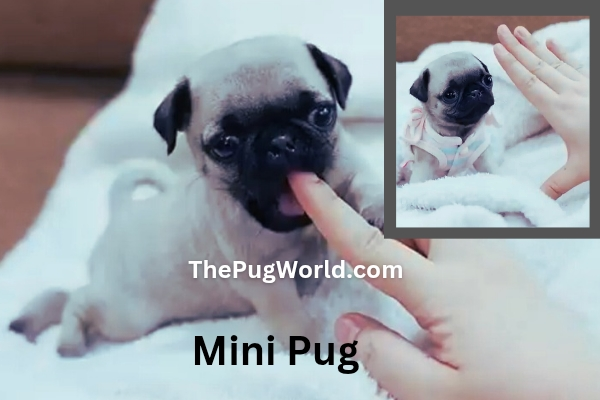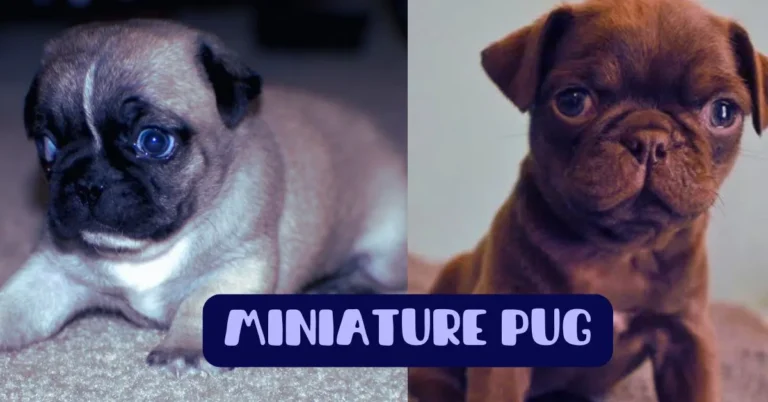Have you ever seen the miniature pug– a pug so tiny that it could fit in your pocket ?
Though officially not recognized by kennel clubs, these miniature pug breed, with their pint sized compact body, wrinkled face and playful charm have stolen the hearts of many.
As a fellow pug enthusiast for many years, and I admit that I am charmed by the idea of these pocket sized pugs.
Let me share with you the joys and challenges of owning a miniature pug along with some essential information on their their care and training.
So get ready to dive into the fascinating world of the mini pug breed.
Miniature pug dog
Miniature pugs can be selectively bred from naturally smaller size pugs, or they can be crossbred with another small breed like the Chihuahua. This mix breed of pug and chihuahua is popularly called the Chug (or Chugg or Pughuahua).
A full grown miniature pug is typically smaller in size than a standard pug and weighs only between 10 and 15 pounds on an average, although depending on their genetics, some may even weigh 20 pounds.
This is why they are also called mini pugs or pocket pugs.
Miniature Pugs
Just like a regular pugs, miniature pugs can have a compact body, a short snout, and large expressive eyes.
They generally have a short, smooth coat that can some in various colors, including brindle, fawn, cream, and white or even black.
These miniature pugs , or mini pugs, as they are often called, are playful, loyal and affectionate dogs.
They are relatively easy to train with positive reinforcements.
The mini pug is not an officially recognized breed as breeders can adopt unethical practices to create a mini pug.
Instagram post shared by @pugdog_of_lovers
Mini Pug
Mini Pugs often have short, flat faces like regular pugs, which can lead to breathing problems.
This condition, called brachycephalic airway syndrome, can cause difficulty in breathing, snoring or noisy breathing, and discomfort in hot, humid weather or after exercise.
Due to their prominent eyes, Mini Pugs can suffer from eye issues like Dry eye , Corneal ulcers , Proptosis.
Just like standard pugs, their skin folds can trap moisture and dirt, leading to Skin infections, allergies and itchiness if not cleaned regularly.
Since the these mini pugs are very small and delicate, owners must be extra careful in their day to day activities to prevent accidental injury.
Owners must be always mindful of their presence, as they can easily be stepped on or hurt unintentionally.
Lots of love, proper care and grooming, regular exercise, and timely vet checkups are crucial for maintaining the overall health and well-being of these small dogs.

Mini Pug Vs Pug
Here is a quick comparison mini pug vs pug.
As the name suggests, mini pugs are smaller versions of regular pugs. They have same general appearance and features -wrinkled face, short muzzle, curled tail – but in a more compact, smaller size.
A typical mini pug weighs around 3 to 10 pounds and stands approximately 6 to 10 inches tall, whereas a standard pug weighs 14 to 18 pounds and stands 10 to 13 inches tall at the shoulder.
Regular pugs are purebred, while mini pugs are selectively bred with smallest pugs, or crossed with a smaller breed like chihuahua to reduce their size.
As a result, mini pugs are not recognized by American Kennel Club (AKC) or any other major kennel club, unlike standard black or fawn pugs,.
As the miniature pug dogs are often the result of crossbreeding or size-focused breeding, they may face more health risks, especially when unethical breeding practices are followed.
Miniature pug puppies are adorable and in high demand , hence they are often more expensive than regular pugs. Standard pugs, on the other hand, are generally more affordable and available.
Teacup Pug
Many times people use the terms mini pugs and teacup pugs interchangeably. However some consider teacups to be an even smaller version.
Regardless of the terminology, neither these miniature pugs nor teacup pugs are recognized by major kennel clubs including the AKC
While both Mini Pugs and Teacup Pugs are smaller than standard Pugs, Teacup Pugs can be much more smaller and more fragile, often weighing under 10 pounds when fully grown.
A teacup pug are often bred in ways that can compromise its health. They have fragile bones and require extra care and supervision and must be handled gently.
If you own a teacup pug, you should be extra careful at home – especially while walking around -to avoid accidentally stepping on your dog or injuring your dog.
They should never be left unsupervised with children, as rough handling can easily cause injury.
While travelling, always use a secure car seat or harness. Aa teacup pug can be seriously injured during sudden movements.
Be patient with house training as smaller dogs have tiny bladders and may need more frequent potty breaks.
Teacup Pugs are sensitive to the weather. Use warm clothing in cold weather and rain gear when it is wet outside.
Handle gently and avoid rough play. These dogs are delicate and can be injured easily by falls or pressure.
In short, teacup pugs are adorable, loyal, and loving companions, but they come with higher risks and greater responsibilities.
FAQ
Are there miniature pugs?
Yes there are miniature pugs often referred to as “teacup pugs” or “toy pugs”. They are a smaller version of the standard pug breed.
They are mostly selectively bred with smaller pug breed or crossbred with small dogs such as Chihuahua to achieve their small size.
Major kennel clubs like AKC do not recognize mini pugs as a separate breed.
How big do miniature pugs get?
A full grown miniature pug typically weighs between 3 to 10 pounds, whereas a regular pug weighs 14-18 pounds on an average.
A miniature pug stands approximately 6 to 10 inches tall, while a regular pug is 10 to 13 inches tall at the shoulders.
What is the life expectancy of a mini Pug?
The life expectancy of a mini pug depends on several factors like breeding practices, genetics, diet and exercise, veterinary care and overall lifestyle.
Mini Pugs which come from healthy bloodlines and are responsibly bred often live longer , whereas those created from unethical practices may have health complications and shorter lifespan.
A balanced diet, regular exercise, routine vet checkups can improve both quality and longevity of their lives.
Summing Up
Miniature pugs are charming, loyal and affectionate, and have all the traits of a standard pug – just in a small package.
These pint sized wonders are undeniably cute, though they are not officially recognized by major kennel clubs.
Along with their adorable features comes several health concerns. Their small size means they require extra care, gentle handling and more health checkups to ensure a long, happy and healthy life.
If you are considering miniature pug puppies, prefer to buy from responsible breeders – who take care of their unique needs and prioritize health and well being of the pug over anything else.
With the right love and care, these small companions can bring love and joy to your home for several years to come.

